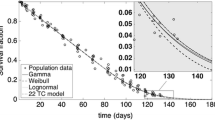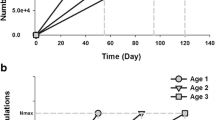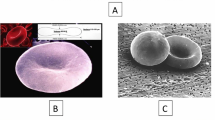Summary
Biotin labeling of red cells was studied using different approaches to see if biotinylation is a useful label for determination of erythrocyte survival. Mouse red cells were labeled with biotin, either in vivo by injection or in vitro. In vivo labeled red cells were followed up in some mice without transfusing the labeled erythrocytes. Furthermore, in vivo labeled as well as in vitro labeled red cells were transfused into syngeneic mice. The biotin label allows an easy discrimination between labeled and unlabeled red cells during FACS analysis, and it is relatively stable for at least 50 days. All the three different approaches give similar results. Mean red cell life spans of in vivo or in vitro labeled red cells either transfused or followed up in vivo were between 44 and 52 days (T50 mean 23.9 days) when red cell destruction was assumed to be only a result of senescence. Mean red cell life spans were between 8 and 18 days (T50 mean 9.5 days) when a random destruction independent of red cell age was suggested. All the survival slopes are neither simple linear functions of time nor logarithmic functions, but they show an overlay of linear function by a logarithmic function where the components of both are unknown.
Similar content being viewed by others
References
Ashby W (1919) The determination of the length of the life of transfused blood corpuscles in man. J Exp Med 29:267–281
Benirschke K, Garner FM, Jones TC (1978) Hematologic disorders. In: Pathology of laboratory animals. I. Springer, Berlin Heidelberg New York
Bentley SA (1977) Red cell survival studies reinterpreted. Clin Haematol 6:601–623
Cavill I, Trevett D, Fisher J, Hoy T (1988) The measurement of the total volume of red cells in man: a nonradioactive approach using biotin. Br J Haematol 70:491–493
Chauhan J, Dakshinamurti K (1986) Purification and characterization of human serum biotinidase. J Biol Chem 261:4268–4275
Cupp JE, Leary JF, Cernichiari E, Wood JC, Doherty RA (1984) Rare-event analysis methods for detection of fetal red blood cells in maternal blood. Cytometry 5:138–144
Dale GL, Norenberg SL (1990) Density fractionation of erythrocytes by Percoll/hypaque results in only a slight enrichment for aged cells. Biochim Biophys Acta 1036:183–187
Hoffmann-Fezer G, Maschke H, Zeitler HJ, et al. (1991) Direct in vivo biotinylation of erythrocytes as an assay for red cell survival studies. Ann Hematol 63:214–217
Hudson IRB, Cavill IAJ, Cooke A, et al. (1990) Biotin labeling of red cells in the measurement of red cell volume in preterm infants. Pediatr Res 28:199–202
Kickler TS, Smith B, Bell W, Drew H, Baldwin M, Ness PM (1985) Estimation of transfused red cell survival using an enzyme-linked antiglobulin test. Transfusion 25:401–405
Kutzsche A (1965) Zur Toxikologie des Dimethylformamids. Arzneim Forsch 6:618–624
Magnani M, Rossi L, Stocchi V, Cucchiarini L, Piacentini G, Fornaini G (1988) Effect of age on some properties of mice erythrocytes. Mech Ageing Dev 42:37–47
Putten LM van (1958) The life span of red cell in the rat and the mouse as determined by labeling with DFP32 in vivo. Blood 13:789–794
Roth KS (1981) Biotin in clinical medicine: a review. J Clin Nutr 34:1967–1974
Slezak SE, Horan PK (1989) Fluorescent in vivo tracking of hematopoietic cells. I. Technical considerations. Blood 74:2172–2177
Sluiter W, Oomens LWM, Brand A, Van Furth R (1984) Determination of blood volumes in the mouse with51chromium-labelled erythrocytes. J Immunol 73:221–225
Suzuki T, Dale GL (1987) Biotinylated erythrocytes: in vivo survival and in vitro recovery. Blood 70:791–795
Zimran A, Forman L, Suzuki T, Dale GL, Beutler E (1990) In vivo aging of red cell enzymes: study of biotinylated red blood cells in rabbits. Am J Hematol 33:249–254
Author information
Authors and Affiliations
Rights and permissions
About this article
Cite this article
Hoffmann-Fezer, G., Mysliwietz, J., Mörtlbauer, W. et al. Biotin labeling as an alternative nonradioactive approach to determination of red cell survival. Ann Hematol 67, 81–87 (1993). https://doi.org/10.1007/BF01788131
Received:
Accepted:
Issue Date:
DOI: https://doi.org/10.1007/BF01788131




